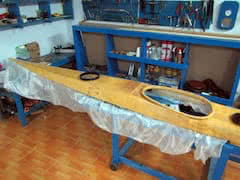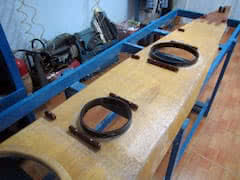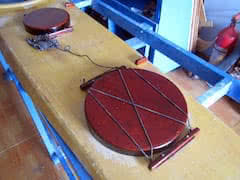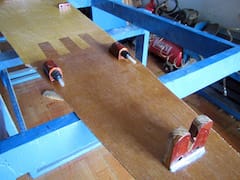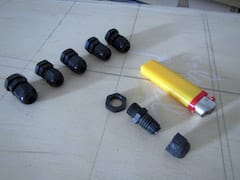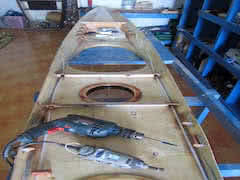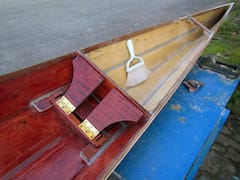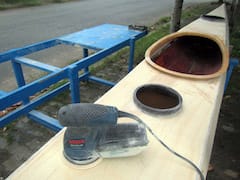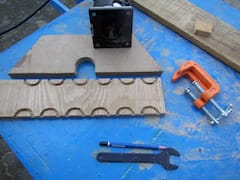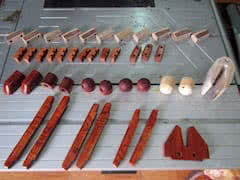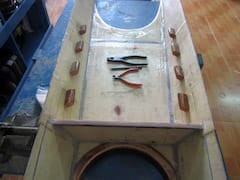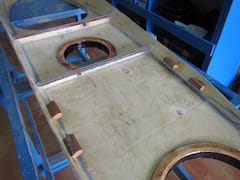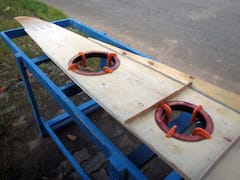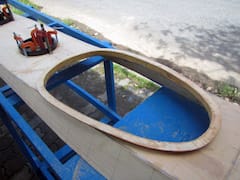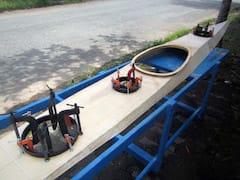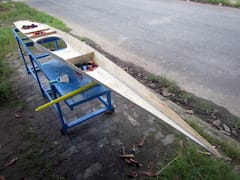 fter joining the hull and deck, the hull receives its final bottom glassing. The fiber fabric would overlap the deck about an inch, to better seal the joint. One little trick to make a clean, tidy line at the painting (or epoxy) boundary: mask the area to paint (or to fill with epoxy) with duct tape. Prior to applying (colored) paint or epoxy, brush the duct tape with a very thin layer of transparent paint (or epoxy).
fter joining the hull and deck, the hull receives its final bottom glassing. The fiber fabric would overlap the deck about an inch, to better seal the joint. One little trick to make a clean, tidy line at the painting (or epoxy) boundary: mask the area to paint (or to fill with epoxy) with duct tape. Prior to applying (colored) paint or epoxy, brush the duct tape with a very thin layer of transparent paint (or epoxy).
Wait for the paint (or epoxy) to cure, than apply the (colored) paint (or epoxy). That way, the colored paint (or epoxy) won’t leak through the duct tape, cause no matter how good the duct tape is, paint (or epoxy) would leak through, causing a blurry, untidy line. Second image: masking with duct tape, prepare for glassing the hull. I run out of my fiberglass fabric roll after this task, also use up the last drop of epoxy! 😀
The hull glassing receives an additional layer of fill coat, then another layer of epoxy at the 3 seams, then a slight sanding. I don’t sand much, just at some rough places. The color scheme for this kayak is also brown / yellow like my previous two boats, but this time, the colors would be much lighter. Next would goes in the vinyl decal decorations, then varnishing the whole hull and deck with transparent PU paint.
Since the deck’s space is used up for the 3 hatches, the bungee cords, the signal light and solar panel, and other accessories, all decorations would go to port and starboard sides: the boat eyes, boat name, and owner’s information! There’re many many other unnamed tasks required still to finish the boat, so I won’t hope to complete it until next week. However, the kayak would see water and start its trial paddling very soon!




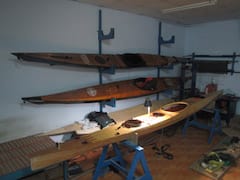
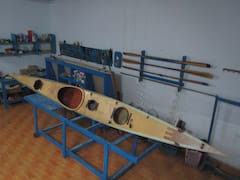
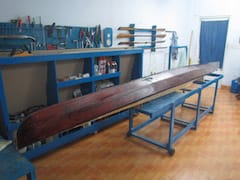
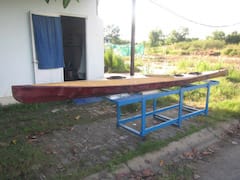
 t’s time to join the hull and deck, and now the boat takes its final shape 😀! The gunwales are bevelled differently along their length to better accommodate the deck, paste some putty on the bevelled edges, then I press the hull and deck together, like the two halves of a peanut shell. 😀 Everything goes on quite smoothly, the bow and aft parts fit very well, just use some duct tapes to press them together.
t’s time to join the hull and deck, and now the boat takes its final shape 😀! The gunwales are bevelled differently along their length to better accommodate the deck, paste some putty on the bevelled edges, then I press the hull and deck together, like the two halves of a peanut shell. 😀 Everything goes on quite smoothly, the bow and aft parts fit very well, just use some duct tapes to press them together.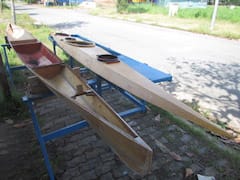
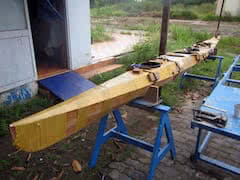
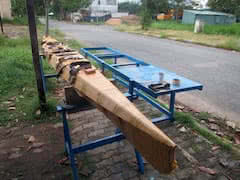
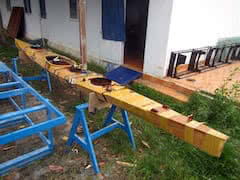
 inished all electrical wiring and device testing. It looks simple, but actually, for me, there were lots of works. First is to figure out how the relay pins work. First image: I noted down the wiring diagram of a relay, the 2 pins on the right, one is NO (normally opened) and one is NC (normally closed). The middle pin on the left (the common pin) supplies power to the targeted devices (here is the compass light, just for testing).
inished all electrical wiring and device testing. It looks simple, but actually, for me, there were lots of works. First is to figure out how the relay pins work. First image: I noted down the wiring diagram of a relay, the 2 pins on the right, one is NO (normally opened) and one is NC (normally closed). The middle pin on the left (the common pin) supplies power to the targeted devices (here is the compass light, just for testing).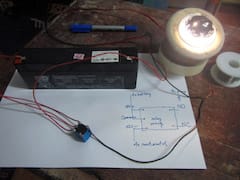
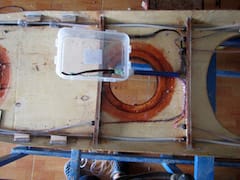
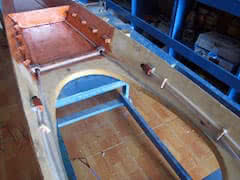
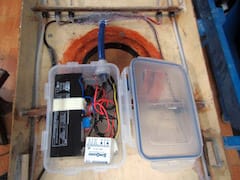
 ext is running the electric wires. I want them to be completely waterproof, so every wire running is placed inside plastic tubes for additional protection. First image: I solder 3 reed switches with wires, place them inside the small wooden bar, seal it completely with epoxy, and glue them under deck inside the cockpit. The letters C, P, L mark the positions of the switches for: compass, pump and light.
ext is running the electric wires. I want them to be completely waterproof, so every wire running is placed inside plastic tubes for additional protection. First image: I solder 3 reed switches with wires, place them inside the small wooden bar, seal it completely with epoxy, and glue them under deck inside the cockpit. The letters C, P, L mark the positions of the switches for: compass, pump and light.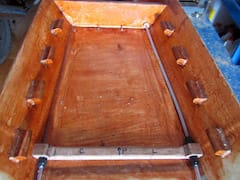
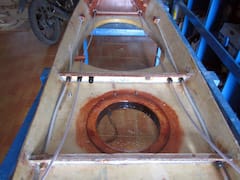
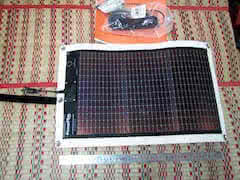
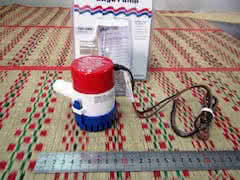
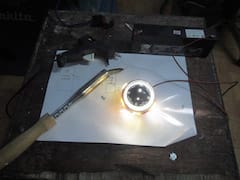
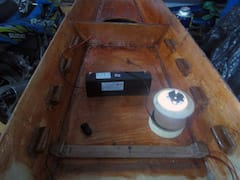
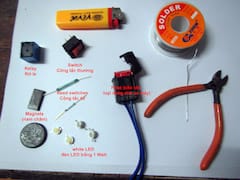
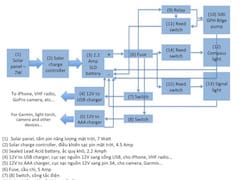
 he deck is stained in a light – yellow color, compared to my previous boats, this kayak would receive a much lighter color scheme. Light, bright color would reveal more the defects on plywood and my building mistakes, but I don’t really care about that anymore, as soon as the faults are not too obvious. Then a thin layer of glass throughout the deck (first image). Next comes various deck fittings.
he deck is stained in a light – yellow color, compared to my previous boats, this kayak would receive a much lighter color scheme. Light, bright color would reveal more the defects on plywood and my building mistakes, but I don’t really care about that anymore, as soon as the faults are not too obvious. Then a thin layer of glass throughout the deck (first image). Next comes various deck fittings.